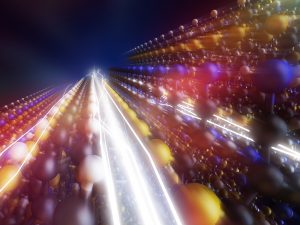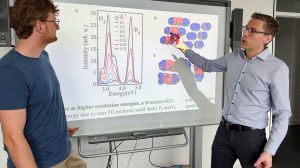The sun sends enormous amounts of energy to the earth. Nevertheless, some of it is lost in solar cells. This is an obstacle in the use of organic solar cells, especially for those viable in innovative applications. A key factor in increasing their performance: Improved transport of the solar energy stored within the material. Now a research group at the Technical University of Munich (TUM) has shown that certain organic dyes can help build virtual highways for the energy.

To improve solar cells, you need a kind of highway for excitons. They are something like the fuel of the sun, which has to be used optimally. (Graphic: Vera Hiendl / e-conversion)
Organic solar cells are light, extremely thin energy collectors and as a flexible coating are a perfect fit on almost any surface: Solar cells based on organic semiconductors open up a range of application possibilities, for example, as solar panels and films which can be rolled up, or for use on smart devices. But one disadvantage in many applications is the comparatively poor transport of the energy collected within the material. Researchers are investigating the elementary transport processes of organic solar cells in order to find ways to improve this transport.
Stimulating sunlight
One of these researchers is Frank Ortmann, Professor of Theoretical Methods in Spectroscopy at TUM. He and his colleagues from Dresden focus more than anything on the mutual interaction between light and material – especially the behavior of what are called excitons. “Excitons are something like the fuel of the sun, which has to be used optimally,” explains Ortmann, who is also a member of the “e-conversion” Excellence Cluster. “When light energy in the form of a photon collides with the material of a solar cell it is absorbed and buffered as an excited state. This intermediate state is referred to as an exciton.” These charges cannot be used as electrical energy until they reach a specially designed interface. Ortmann and his team have now shown that what are referred to as exciton transport highways can be created using organic dyes.
Turbocharger dyes

Prof. Frank Ortmann (right) and Maximillian Dorfer discuss how specific dye molecules can increase efficiency in organic solar cells. (Photo: S. Reiffert / TUM)
The reason it is so important that the excitons reach this interface as quickly as possible has to do with their short lifespan. “The faster and more targeted the transport, the higher the energy yield, and thus the higher the efficiency of the solar cell,” says Ortmann. The molecules of the organic dyes, referred to as quinoid merocyanines, make this possible, thanks to their chemical structure and their excellent ability to absorb visible light. Accordingly, they are also suitable for use as the active layer in an organic solar cell, Ortmann explains.
Energy packets in the fast lane
Using spectroscopic measurements and models the researchers were able to observe the excitons racing through the dye molecules. “The value of 1.33 electron volts delivered by our design is far above the values found in organic semiconductors – you could say the organic dye molecules form a kind of super-highway,” Ortmann adds. These fundamental new findings could pave the way for targeted, more efficient exciton transport in organic solid matter, accelerating the development of organic solar cells and organic light emitting diodes with even higher performance. (Author: Caroline Zörlein, e-conversion)
Publication
Directed Exciton Transport Highways in Organic Semiconductors.
Kai Müller, Karl S. Schellhammer, Nico Gräßler, Bipasha Debnath, Fupin Liu, Yulia Krupskaya, Karl Leo, Martin Knupfer, Frank Ortmann
DOI: 10.1038/s41467-023-41044-9
https://www.nature.com/articles/s41467-023-41044-9
Contact
Prof. Frank Ortmann
Technical University of Munich
Professorship of Theoretical Methods in Spectroscopy
Mail: frank.ortmann@tum.de
